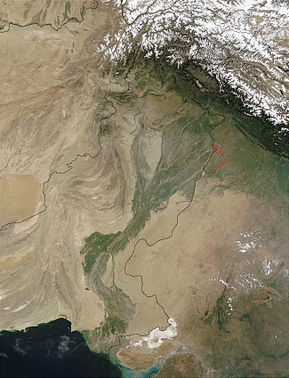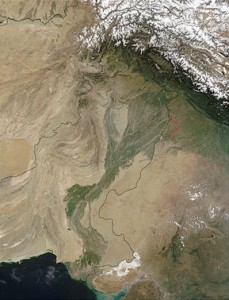
“Connecting the Drops” – New Report Highlights the Challenges in the Indus Basin
The Stimson Center, in coordination with Sustainable Development Policy Institute has published a report entitled Connecting the Drops: An Indus Basin Roadmap for Cross-Border Water Research, Data Sharing and Policy Coordination. On March 20, The Stimson Center hosted an event with David Michel, director of their environmental security program, Winston Yu from the World Bank and Satu Limaye, director of the East West Center, to discuss the preliminary findings.
Spanning 3,200km across southern Asia, the Indus Basin is an indispensable water source for hundreds of millions of people. However, the existing political, social, and economic tensions within and between bordering nations, particularly India and Pakistan, currently overshadow the troubling projected impacts climate change will have on the region. At the forefront of these issues is the increasing strain on water resources, a frightening reality for which there is not yet a battle plan. The report aims to “illuminate the landscape of policy choices and chart many potential pathways forward.”
The Stimson Center, the sustainable Development Policy Institute (SDPI), and the Observer Research Foundation (ORF), collaborated to bring in 25 diverse analysts and specialists to formulate the interdisciplinary and international Indus Basin Working Group. The goal of this working group was to assess what information that science could provide and what information decision makers need. The group collaborated over the course of 6 months with workshops and web correspondence and developed suggestions for developing successful trans-border water management operations.
The group recommended the following: Prioritize investment in and institutionalize regular maintenance of canal infrastructure to minimize agricultural water losses; improve cross-border data sharing of hydrological information; implement new mapping technologies to monitor groundwater supplies; and collaborate internationally in research efforts.
The report states that “coordination and exchange across national and disciplinary boundaries will be essential to overcoming this science/policy gap and to providing decision makers with holistic perspectives on the multiple risks weighing on the Indus Basin and the consequent policy choices and possibilities facing the riparian nations.”
Obviously, cooperation will be crucial for these countries in dealing with the growing water crisis. However, this is far easier said than done. As it stands, cooperating on water management issues simply isn’t a government priority – political, social and economic issues take center stage. Even internally, as ASP’s blog has previously mentioned, there is a disconnect between state and local authorities, making dealing with the impacts of climate change a struggle.
It’s a catch-22, as a lot of the socio-political factors and regional stresses are a result of the strain on crucial resources, but since these issues are not being addressed, they grow worse. The lack of infrastructure being dedicated to data collection is an acute problem, which is why 3rd party organizations are the ones carrying out this preliminary research.
Every day, water slips through the fingers of the Indus River Basin’s population, and unless the Pakistani and Indian authorities prioritize water governance, the problems facing the Indus Basin will only compound. The efforts by 3rd parties such as the Stimson Center, SDPI, and ORF provide a useful road-map for policy coordination between the nations of the Indus Basin, but ultimately the region’s sovereign governments need to take charge.







[…] ‘Perspectives’ article, “The Dams of the Himalayas” and these blog posts: here, here, and here (from my previous […]